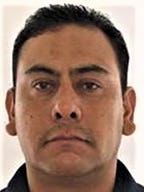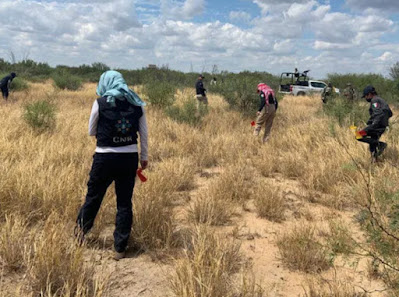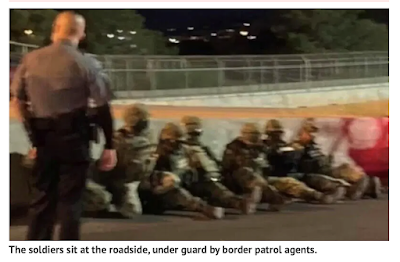"Sol Prendido" for Borderland Beat
A new video from the Mexican underworld has just surfaced online. For this broadcast the interrogation and mass execution of captured enemies takes place outside in an undisclosed location somewhere in the state of Guerrero.
The following films are extensive in length. Just as well the discovery of what lead to their demise is narrated by every captive who is questioned.
In addition the final video concludes with 2 hitmen on the ground being dismembered. The right leg of the first captive is removed at the knee with a 12 inch blade scythe. When he speaks he sounds like he’s sedated. There’s no indication that he’s feeling what’s happening to him.
Video translation is as follows:
Sicario #1: To all the citizens of Iguala. Here are all the cowards who were extorting and murdering innocent civilians and women. This is the trash that had this beautiful city terrorized. We warned everyone and now the time has come. This drug corridor already has an owner. Every operative from La Bandera hung their narco messages.
And now look at where you sons of bitches are at now. Cachetes, you faggot. We have all of your piece of shit gunmen here. Chucho Brito, the same goes for you traitor. You son of a bitch. You already had your position at the table made beforehand. So that you could suck off Gama. As you’ve done so for most of your life.
We extended a hand to you. And you bite the hand you piece of shit jerk off. Just as you’ve done so with others who’ve helped. You son of a bitch. Here before you are La Gente de La Sierra you cowards. And La Sierra doesn’t forgive. You will fall into formation with us. Otherwise, we will kill you off you pieces of shit.
Sicario #2: Whats your name?
Captive #1: Juan Manuel aka El Marin.
Captive #2: Simon.
Sicario #2: Whats your name?
Captive #3: Omar Beltran Alvarez aka Mostró.
Captive #4: Guillermo Serecen Navarro.
Sicario #2: Speak louder!
Captive #4: Guillermo Serecen Navarro.
Sicario #2: Who’s your boss?
Captive#4: Chucho Brito.
Sicario #2: Whats your name?
Captive #5: Julio González Moreno aka El Camaleón sir.
Sicario #2: Here’s that son of a bitch Randy!
Captive #6: Ignacio Jose Cerrano aka El Rafi.
Sicario #2: And who’s your boss?
Captive #6: Chucho Brito.
Captive #7: Sergio Ramirez Carreto aka El Tarro. My boss is Chucho Brito.
Captive #8: Giovani Ravaran Ramirez. My boss is Chucho Brito.
Captive #9: Luis Adan aka El W.
Captive #10: Aldo Lopez aka Casarubias. I belong to the Garrafos. My boss is Chucho Brito.
Captive #11: Uval Tavares Perez aka Bubalin.
Captive #12: Andres Rodriguez Sanchez. My boss is Chucho Brito.
Sicario #2: You just all fucked yourselves you sons of bitches.
(Sicario #2 moves back towards the beginning of line to continue his interrogation. The actual questioning begins several males away from first captive)
Sicario #2: What does your boss Chucho Brito specialize in?
Captive #3: He has a direct connect with City Hall.
Sicario #2: Speak louder!
Captive #3 He has a direct connect with City Hall.
Sicario #2: What does he specialize in?
Captive #3: He’s the one who takes the money out of the construction sites.
Sicario #2: What does Chucho Brito specialize in?
Captive #5: He works with City Hall to collect as much money as he can.
Sicario #2 What does your boss specialize in?
Captive #6: He would take all the money he could from City Hall.
Sicario #2: And just what position did you guys hold?
Captive #3: I would prepare drugs
Sicario #2: And you?
Captive #1: I would also prepare drugs.
Sicario #2: And you?
Captive #2: I was a hitman.
Sicario #2: Speak louder!
Captive #2: I was a hitman.
Sicario #2: And you?
Captive #4: I was a sica (hitman).
Sicario #2: Speak louder!
Captive #4: I was a sica sir.
Sicario #2: And you what did you specialize in?
Captive #5: Hitman.
Captive #6: Hitman.
Sicario #2: And you?
Captive #7: I would sneak things into the Cereso prison.
Sicario #2:Speak louder!
Captive #7: I would sneak things into the Cereso prison.
Sicario #2: Which things exactly would you sneak in?
Captive #7: Marijuana, cocaine, and beer.
Sicario #2: And you?
Captive #8: Hitman.
Sicario #2: Speak louder!
Captive #8 Hitman.
Captive #9: I collected protection fees.
Sicario #2: And you?
Captive #10: I would clean for them?
Sicario #2: Speak louder!
Captive #10: I would clean for them.
Sicario #2: And just what would you clean for them?
Captive #10: I would service their aircrafts.
Captive #11: I would prepare cocaine for them.
Sicario #2: Wicho, where exactly were you in charge of?
Wicho: In the towns of Tepecua (Tepecuacuilco de Trujano) and Huitzico.
Sicario #2: Where else?
Wicho: (Unintelligible).
Sicario #2: How many men do you have there?
Wicho: 19.
Sicario #2: And you Fersi. Lift up your face bro.
Fersi: I was in charge in Iguala. I was the boss for the hitmen.
Sicario #2: Which homicides did you participate in?
Fersi: I was involved in homicides. And more as well.
Sicario #2: Which ones exactly?
Fersi: I was involved in…in every one that has ever taken place.
Sicario #2: Who did you hand over those women to have killed?
Fersi: I handed them over to Wicho.
Sicario #2: Where did this take place.
Fersi: It happened at La Morenita.
Sicario #2: On whose orders?
Fersi: On Colin’s and Chucho Brito’s orders.
Sicario #2: And why did this take place?
Fersi: Because they were ratting us out.
Sicario #2: How many women have been killed?
Fersi: Just one.
Sicario #2: And what happened to the rest?
Fersi: I handed them over to Colin and La Beba.
Sicario #1: Citizens of Iguala. Here’s all the trashy individuals who were extorting, thieving, and killing innocent civilians. They all fucked themselves in the end. Long live the Gente de La Sierra you sons of bitches. This plaza already has an owner.
Sicarios in unison scream: Long live!
*
Video #4 concludes with:
Captive #1: Cousin. Cousin please forgive me. For real please forgive me.
Captive # 2 is screaming away in horrible pain. The broadcast closes with the rest of the captives on their knees watching and waiting in the background for their turn.
Guerrero, México
Muerte X Glorious Dead 69







































